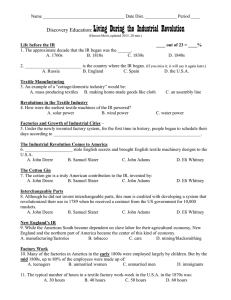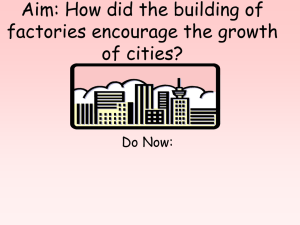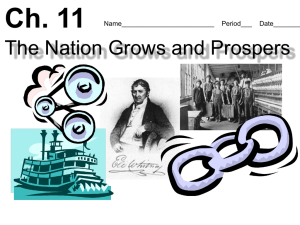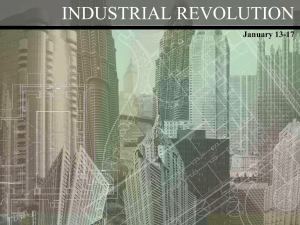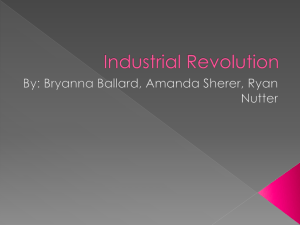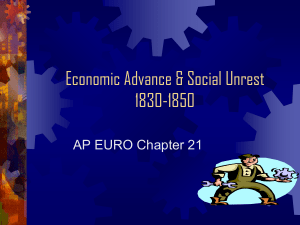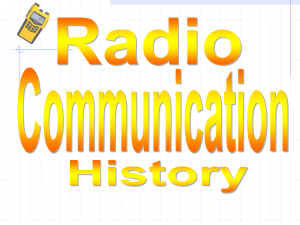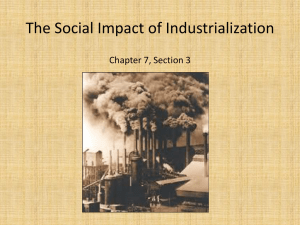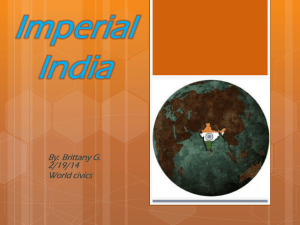Industry Review
advertisement
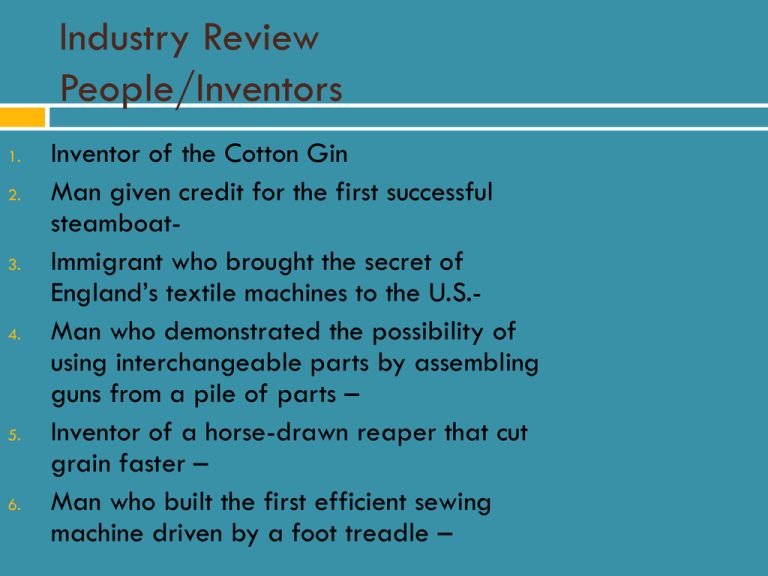
Industry Review People/Inventors 1. 2. 3. 4. 5. 6. Inventor of the Cotton Gin Man given credit for the first successful steamboatImmigrant who brought the secret of England’s textile machines to the U.S.Man who demonstrated the possibility of using interchangeable parts by assembling guns from a pile of parts – Inventor of a horse-drawn reaper that cut grain faster – Man who built the first efficient sewing machine driven by a foot treadle – Industry Review People/Inventors 7. 8. 9. 10. 11. 12. Designer and builder of the first practical steam locomotive – Man who thought of dots and dashes to convey messages across telegraph wires – Man who improved farming by making plowshares out of steel instead of cast iron – Man who accidentally discovered that heating rubber makes it more useful – Man who made his fortune with steamships and went on to control the New York Central Railroad – Man who developed a new factory where spinning, dyeing, and weaving were together in one building – Industry Review Places 13. 14. 15. 16. 17. 18. 19. Kind of community to which people began moving to be near their work – Section of the nation that welcomed the invention of the cotton gin – This connected Lake Erie and the Hudson River – Country in which the Industrial Revolution began – Sources of power along which early factories were located – River that the Erie Canal followed – Section of the U.S. where most of the early factories were found – Industry Review Places and Uses 20. 21. 22. 23. 24. 25. 26. 27. Two cities joined by the first telegraph line – State that boasted the first water-powered textile factory in the country – River on which the Clermont was first seen – Means of sending messages using the telegraph – Fee charged to use many roads in the 1800s – Name given to the first steam locomotive – Device that allowed messages to travel rapidly between Europe and the U.S. – Activity for which a post road was used – Industry Review Places, People, and Essentials 28. 29. 30. 31. 32. 33. 34. 35. 36. Place where workers make a product – The first important factories in the United States – Most of the work on the Southern plantations was done by these people – Term that describes the drastic change during the 1800s in the way things were produced and distributed – Process in which interchangeable parts allowed huge amounts of goods to be produced – People who came to the U.S. to work in factories – Eli Whitney’s idea: a series of parts that would fit any model of a given product – War that spurred the growth of American manufacturing – Using tools and knowledge to improve conditions - Industry Review People/Inventors 1. 2. 3. 4. 5. 6. Inventor of the Cotton Gin Eli Whitney Man given credit for the first successful steamboat Robert Fulton Immigrant who brought the secret of England’s textile machines to the U.S. Samuel Slater Man who demonstrated the possibility of using interchangeable parts by assembling Eli Whitney guns from a pile of parts – Inventor of a horse-drawn reaper that cut Cyrus McCormick grain faster – Man who built the first efficient sewing machine driven by a foot treadle – Isaac Singer Industry Review People/Inventors 7. 8. 9. 10. 11. 12. Designer and builder of the first practical steam locomotive – Man who thought of dots and dashes to convey messages across telegraph wires – Man who improved farming by making plowshares out of steel instead of cast iron – Man who accidentally discovered that heating rubber makes it more useful – Man who made his fortune with steamships and went on to control the New York Central Railroad – Man who developed a new factory where spinning, dyeing, and weaving were together in one building – Peter Cooper Samuel Morse John Deere Charles Goodyear Cornelius Vanderbilt Francis Cabot Lowell Industry Review Places 13. 14. 15. 16. 17. 18. 19. Kind of community to which people began moving to be near their work – Section of the nation that welcomed the invention of the cotton gin – This connected Lake Erie and the Hudson River – Country in which the Industrial Revolution began – Sources of power along which early factories were located – River that the Erie Canal followed – Section of the U.S. where most of the early factories were found – City South Erie Canal Great Britain Rivers Mohawk R. New England Industry Review Places and Uses 20. 21. 22. 23. 24. 25. 26. 27. Two cities joined by the first telegraph line –Washington DC and Baltimore, MD State that boasted the first water-powered Rhode Island textile factory in the country – River on which the Clermont was first seen – Albany Means of sending messages using the Morse Code telegraph – Fee charged to use many roads in the Toll 1800s – Name given to the first steam locomotive – Tom Thumb Device that allowed messages to travel Telegraph rapidly between Europe and the U.S. – Activity for which a post road was used – Mail delivery Industry Review Places, People, and Essentials 28. 29. 30. 31. 32. 33. 34. 35. 36. Place where workers make a product – The first important factories in the United States – Most of the work on the Southern plantations was done by these people – Term that describes the drastic change during the 1800s in the way things were produced and distributed – Process in which interchangeable parts allowed huge amounts of goods to be produced – People who came to the U.S. to work in factories – Eli Whitney’s idea: a series of parts that would fit any model of a given product – War that spurred the growth of American manufacturing – Using tools and knowledge to improve conditions - Factories New England Textile mills Slaves Industrial Revolution Mass production Immigrants Interchangeable parts War of 1812 Technology
